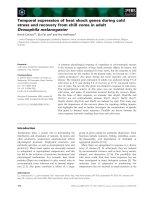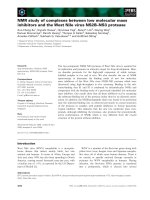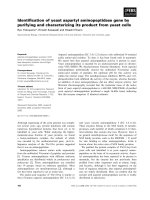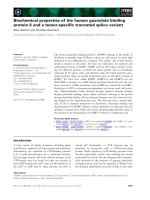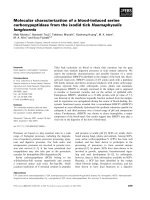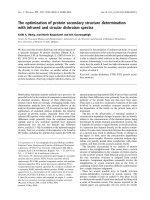Báo cáo khoa học " Chitin content of cultivated mushrooms Agaricus bisporus, Pleurotus ostreatus and Lentinula edodes Janos Vetter " doc
Bạn đang xem bản rút gọn của tài liệu. Xem và tải ngay bản đầy đủ của tài liệu tại đây (103.94 KB, 4 trang )
Chitin content of cultivated mushrooms Agaricus bisporus, Pleurotus
ostreatus and Lentinula edodes
Janos Vetter
*
Department of Botany, Faculty of Veterinary Science, Szent Istva
´
n University, P.O. Box 2, Rottenbiller 50, H-1400 Budapest, Hungary
Received 18 September 2005; received in revised form 27 December 2005; accepted 23 January 2006
Abstract
The chitin contents of pileus and stipes of fruit bodies of Agaricus bisporus, Pleurotus ostreatus and Lentinula edodes (shii take) were
determined and compared. The fruit bodies of different, common varieties of the cultivated mushroom species were taken from Hungar-
ian and German large-scale farming. The analytical procedure was carried out on the powder of cleaned, dried and milled pileus and
stipes. The pileus of A. bisporus variety ‘K-23’ showed a significant decrease (p < 0.05) during the cultivation’s flushes (breaks), 1–3, while
the chitin level of stipes seemed to be constant. The other analysed A. bisporus varieties (var. ‘158’, ‘K-7’, ‘Sylvan A-15’, ‘Sylvan 608’, and
Le Lion C-9) had practically the same chitin levels. This indicates that the chitin content is a stable characteristic of the species and there
are no significant differences between the different varieties. The chitin levels of pileus and stipes were not significantly different (for A.
bisporus, 6.68 and 7.25) but showed significant differences for P. ostreatus (p < 0.05) and L. edodes (p < 0.001). In the case of the latter
two species, the pileus had the higher and the stipe the lower chitin content. The presented data confirm that a mushroom saprotrophic
(A. bisporus) had higher chitin level than had the wood-rotting ones (P. ostreatus, L. edodes).
Ó 2006 Elsevier Ltd. All rights reserved.
Keywords: Chitin; Fruit body; Pileus; Stipe; Agaricus bisporus; Pleurotus ostreatus; Lentinula edodes
1. Introduction
The edible cultivated mushrooms have some valuable
properties (remarkable quantity and high quality of pro-
teins, low energy level, some important elements such as
K and P, some odorous and taste materials) and valuable
and important foods. The contents of these favourable
components have been reported in different publications
(Kasuga, Fujihara, & Aoyagi, 1999; Manzi, Gambelli,
Marconi, Vivanti, & Pizzoferrato, 1999; Manzi, Aguzzi,
& Pizzoferrato, 2001; Mattila, Lampi, Ronkainen, Toivo,
& Piironen, 2002). The chemical composition of these
mushrooms, however, shows other constituents, which
can effect (limit) the digestibility or have other negative
effects.
The main components of the fungal cell wall are the
polysaccharides (80–90% of the dry mass). The N-contain-
ing chitin is one of the skeletal fungal polysaccharides
responsible for the rigidity and shape of the cell wall. Chi-
tin is a characteristic component of the taxonomical groups
Zygo-, Asco-, Basidio- and Deuteromycetes, but it is
absent in other groups (for e.g., Oomycetes). The fungi,
according to many new fungal systems, are organisms with
a chitin-containing cell wall. The other fungal or fungi-like
organisms without such cell walls are ranked among the
kingdoms Protista or Chromista.
The dietary fibre (total dietary fibre = TDF) is the sum
of the intrinsic non-digestible carbohydrates and lignin
(plants) and the sum of such carbohydrates (mainly of chi-
tin) in mushrooms. The Lentinula edodes (shii take) con-
tains about twice the TDF of the brown strain of
Agaricus bisporus (Mattila et al., 2002).
Chitin molecules decrease the digestibility. However,
they have a positive biological role as a component of
0308-8146/$ - see front matter Ó 2006 Elsevier Ltd. All rights reserved.
doi:10.1016/j.foodchem.2006.01.037
*
Tel./fax: +36 1 478 4238.
E-mail addresses: ,
www.elsevier.com/locate/foodchem
Food Chemistry 102 (2007) 6–9
Food
Chemistry
dietary fibres (Bauer-Petrovska, Jordanoski, Stefov, &
Kulevanova, 2001; Cheung, 1996).
We earlier analysed the chitin content of the most
important wild-growing mushroom species (Vetter & Siller,
1991) and a difference of chitin content of between 2% and
8.5% (to DM) was established. The chitin level of three
varieties of Pleurotus ostreatus varied between 2.16% and
3.31% of DM. According to data of Manzi et al. (2001)
the cooking of A. bisporus increased the chitin content
for normal, fresh mushro oms, for the deep frozen and for
the canned variants, too (control, 6.0%; cooked 7.0%; deep
frozen; 3.4%, cooked 5.2%; canned: 6.1%, cooked 7.4%).
Unfortunately, the variety of the examined mushroom
was unknown, the fruit bodies were whole (and not frac-
tionated). The chitin content of the wild-growing Boletus
group ranged from 0.5 to 3.3 g/100 g edible weight, and
the effect of cooking was not significant (Manzi, Marconi,
Aguzzi, & Pizzoferrato, 2004). The main drawback of pre-
vious literature was the small number of analysed samples
and of species or of varieties, and the absence of data on
chitin contents of two morphological parts of fruit body
(pileus and stipe).
The aims of these investigations were: (a) to evaluate the
changes of chitin content of A. bisporus during the cultiva-
tion process (are there differences in chitin content among
the repeating 3–5 day cycles, i.e., flushes or breaks of culti-
vation?), (b) to compare the chitin contents of two parts of
sporocarps (pileus and stipe) of the three cultivated species
and to establish and compare the chitin contents of some
common and frequent ly used varieties, such as the most
important cultivated mushroom species (A. bisporus,
P. ostreatus, L. edodes).
2. Materials and methods
The fruit bodies of the different varieties and species
originated from large scale cultivation, i.e., mainly from
the National Korona Mushroom Union (Kerecsend, Hun-
gary), but some varieties were cultivated in Germany by
GAMU (Krefeld, Germany). The samples of A. bisporus
var. ‘K-23’ were taken from three flushes (or breaks) of
four independent cultivations (two in 1999 and in 2000).
The cultivations of other varieties (species) were done in
2000; the samples were taken from the first flush. The ana-
lysed species and varieties were:
(1) A. bisporus (Lange) Imbach, varieties ‘K-23’, ‘K-7’
‘158’, Sylvan A-15; ‘Sylvan 608’ Le Lion C-9; (2) P. ostre-
atus (Jacq. et Fr.) Kummer varieties G-32, G-24, H-7 357,
Somycel HK-35; Amycel 3015; and (3) L. edodes (Berg.)
Sing. varieties ST-66, ST-67. The fruit bodies were cleaned,
separated into pileus and stipes, dried and milled. The chi-
tin determinations were carried out from the mushroom
powders. The hydrolysis of the samples (20–20 mg) was
carried out in 6 N HCl solution (in 2.5 cm
3
, at 106 °C,
24 h). The glucoasamine content of the hydrolysed and
neutralized material was determined with 3-methyl-2-ben-
zothiazolone-hydrazone-hydrochloride (MBTH) according
to Smith and Gilkerson (1979). The determinations were
done triplicate, and chitin contents were given as the arith-
metical means (in percent of DM) with standard deviations
(±SD). The statistical evaluation of the analytical data
were performed by using the software ‘Origin 4.0’.
3. Results and discussion
The chitin contents of different parts of fruit bodies of A.
bisporus var. ‘K-23’ are given in Table 1.
The chitin concentrations of flushes 1–3 showed a
decreasing tendency for pileus: 7.21% of DM; 7.16% of
DM; 5.63% of DM and relatively constant level for stipes:
7.01; 7.29; and 6.94 (for flushes 1, 2 and 3, respectively).
Comparing the data of flushes for pileus, between flus hes
1 and 3 there was a significant difference (p < 0.05), but
among the other consecutive flushes (1–2; 2–3) there were
no significant differences. No signi ficant differences were
demonstrated between the flushes for stipes. This fact
seems to be a stable characteristic because the mushroom
samples for this evaluation were taken from independent
cultivation cycles (from the years 1999 and 2000).
The chitin contents of other varieties of A. bisporus are
summarized in Table 2. The analysed varieties (‘158’;
‘K-7’, ‘Sylvan A-15’, ‘Sylvan 608’, ‘Le Lion C-9’) all have
practically the same level of chitin in fruit bodies, because
the differences are not significant. This stability of chitin
Table 1
Chitin contents of different flushes (breaks) of Agaricus bisporus var.
‘K-23’
Part of
fruit
body
Year and
number of
examination
Flushes Chitin
content
(% DM) ± SD
Mean of all
samples
(±SD)
Pileus
chitin/
stipe
chitin
Pileus
(cap)
1999/1 No. 1 7.25 ± 0.09 7.21 ± 0.51 0.93
1999/2 7.48 ± 0.17
2000/1 7.64 ± 0.15
2000/2 6.47 ± 0.06
Stipe 1999/1 No. 1 8.35 ± 0.08 7.61 ± 0.90
1999/2 8.70 ± 0.14
2000/1 7.54 ± 0.12
2000/2 6.81 ± 0.12
Pileus
(cap)
1999/1 No. 2 8.31 ± 0.08 7.16 ± 1.0 0.98
1999/2 7.73 ± 0.23
2000/1 6.26 ± 0.10
2000/2 6.37± 0.09
Stipe 1999/1 No. 2 8.74 ± 0.27 7.29 ± 1.34
1999/2 8.13 ± 0.34
2000/1 5.97 ± 0.19
2000/2 6.34 ± 0.10
Pileus
(cap)
1999/1 No. 3 5.64 ± 0.22 5.63 ± 1.02 0.81
1999/2 6.85 ± 0.16
2000/1 5.70 ± 0.15
2000/2 4.35 ± 0.18
Stipe 1999/1 No. 3 7.47 ± 0.27 6.94 ± 2.23
1999/2 9.66 ± 0.21
2000/1 6.34 ± 0.11
2000/2 4.31 ± 0.18
J. Vetter / Food Chemistry 102 (2007) 6–9 7
concentration indicates that the cell wall structure is prac-
tically independent of the varieties.
The average data of all pileus samples of A. bisporus are
always lower than those of stipes (their rate: 0.91) but the
difference is not significant. The calculated means of all
data are: 6.67% DM (±1.04) and 7.31% DM (±1.43) for
pileus and for stipes, respectively.
Table 3 contains the chitin concentration of P. ostreatus
fruit bodies (and, for the sake of comparison, the results of
six data groups from our earlier work (Vetter & Siller,
1991)). The averages of the data for P. ostreatus varieties
are: 3.78% DM (±0.97) and 2.8% DM (±0.75) for pileus
and for stipes, respectively. The difference of chitin levels
of pileus and stipes is significant (p < 0.05); their ratio is
(1.35). The same data for L. edodes (Table 4) show, that
the pileus has a significantly higher amount of chitin
(8.07% DM) than the stipes (6.55); their ratio is 1.20.
Our previous results on wild-growing mushroom species
(Vetter & Siller, 1991) demonstrated the role of fungal
nutrition type in the regula tion of chitin level, i.e., the sap-
rotrophic groups had a higher, and the wood-destroying
one a significantly lower content. The consequences of
the presented studies are similar: the cultivated sapro-
trophic Agaricus species had higher, and the wood-rotting
L. edodes, and mainly the P. ostreatus, the lower levels. The
published data on chitin contents of our most important
cultivated mushrooms were sporadic. Our present data
are totally confirmed by the data of Manzi et al. (2001)
for A. bisporus (whole fruit body) and for P. ostreatus.
The biological role of the TDF (glucan and of chitin) of
mushrooms was recently evaluated. Five percent of chitin
in the diet of Wistar rats (Zacour, Silva, Cecon, Bambirra,
& Vieira, 1992) caused lower protein digestibility, but
reduced levels of liver triacylglycerol s an d cholesterols
and higher excretion of triglycerides in faeces. The choles-
terol levels wer e significantly lower in other groups of Wis-
tar rats (Mathew & Ramachandran-Nair, 1998) fed 0.5%
chitin or partially hydrolysed chitin during 13 weeks.
Based on the experimental data the following conclu-
sions were drawn:
1. Chitin content of the cultivat ed mushrooms is a charac-
teristic of the species and seems to be independent of the
cultivars (varieties).
2. Chitin level of the pileus (cap) is – in general – higher,
than of stipes. These differences can be significant (for
A. bisporus) or non-significant (for P. ostreatus and
L. edodes).
3. The fruit bodies of the consecutive cultivation flushes
(breaks) show a small decrease in chitin content of pileus
or a practically constant level in stipes for the variety
‘K-23’ of A. bisporus.
4. The chitin level of the cultivated mushrooms – like the
wild growing ones – is also regulated by nutrition type
of the species.
5. The chitin of our cultivated mushrooms is not only a
stable chemical component of the fungal cell wall, but
has an important role in the nutritional value of
mushrooms.
Acknowledgements
The author wishes to express his acknowledgement to
Professor Jan Lelley (GAMU, Krefeld, Germany) and to
Csaba Hajdu (National Korona Mushroom Union, Kerec -
send, Hungary) for their help in the cultivation of the
examined mushrooms.
References
Bauer-Petrovska, B., Jordanoski, B., Stefov, V., & Kulevanova, S. (2001).
Investigation of dietary fibre in some edible mushrooms from
Macedonia. Nutrition and Food Science, 31, 242–246.
Table 3
Chitin concentration of different varieties of Pleurous ostreatus
Variety and part of fruit body Chitin content
(% DM) ± SD
Pileus chitin/
stipe chitin
Var. ‘G-32’, pileus
a
3.31 ± 0.41 1.37
Var. ‘G-32’, stipe
a
2.42 ± 0.40
Var. ‘H-7’, pileus
a
3.06 ± 0.44 1.30
Var. ‘H-7’, stipe
a
2.36 ± 0.36
Var. ‘G-24’, pileus
a
2.93 ± 0.21 1.36
Var. ‘G-24’, stipe
a
2.16 ± 0.37
Var. ‘357’, pileus (Exp. No. 1) 5.05 ± 0.24 1.28
Var.‘357’, stipe (Exp. No. 1) 3.93 ± 0.19
Var. ‘357’, pileus (Exp. No. 2) 4.87 ± 0.22 1.34
Var. ‘357’, stipe (Exp. No. 2) 3.63 ± 0.10
Var. ‘357’, pileus (Exp. No. 3) 5.46 ± 0.17 1.43
Var. ‘357’ stipe (Exp. No. 3) 3.83 ± 0.16
Var. unknown, pileus 3.87 ± 0.19 1.25
Var. unknown, stipe 3.09 ± 0.07
Somycel ‘HK-35’ whole fruit body 4.77 ± 0.16
Amycel ‘3015’, whole fruit body 4.95 ± 0.13
a
According to our earlier work (Vetter & Siller, 1991).
Table 4
Chitin contents of Lentinula edodes (shii take) varieties
Variety and part of fruit body Chitin content
(% DM) ± SD
Pileus chitin/
stipe chitin
Var. ‘ST-67’, stipe 8.07 ± 0.19
Var. ‘ST-66’, pileus 6.55 ± 0.18 1.20
Var. ‘ST-66’, stipe 5.46 ± 0.17
Var. unknown, whole fruit body 5.36 ± 0.23
Table 2
Chitin contents of other varieties of cultivated Agaricus bisporus
Variety and part of fruit body Chitin content
(% DM) ± SD
Pileus chitin/
stipe chitin
Var. ‘158’, pileus (Exp. No. 1) 6.72 ± 0.23 0.87
Var. ‘158’, stipe (Exp. No. 1) 7.74 ± 0.16
Var. ‘158’, pileus (Exp. No. 2) 7.23 ± 0.21 0.92
Var. ‘158’, stipe (Exp. No. 2) 7.84 ± 0.21
Var. ‘K-7’, pileus 6.17 ± 0.13
Var. ‘Sylvan A-15’ whole fruit body 8.68 ± 0.34
Var. ‘Sylvan 608’ 8.16 ± 0.21
Var. ‘Le Lion C-9’ 8.88 ± 0.14
Var. ‘Le Lion C-9’ open 8.47 ± 0.28
8 J. Vetter / Food Chemistry 102 (2007) 6–9
Cheung, P. C. K. (1996). Dietary fiber content and composition of some
cultivated edible mushroom fruiting bodies and mycelia. Journal of
Agricultural and Food Chemistry, 44, 468–471.
Kasuga, A., Fujihara, S., & Aoyagi, Y. (1999). The relationship between
the varieties of dried shiitake mushrooms (Lentinus edodes (Berk.)
Sing.) and chemical composition. I. The effect of the varieties of dried
shiitake mushrooms on their taste. Journal of Japanese Society Food
Science and Technology, 46, 692–703.
Manzi, P., Aguzzi, A., & Pizzoferrato, L. (2001). Nutritional value of
mushrooms widely consumed in Italy. Food Chemistry, 71, 321–325.
Manzi, P., Gambelli, L., Marconi, S., Vivanti, V., & Pizzoferrato, L.
(1999). Nutrients in edible mushrooms: an interspecies comparative
study. Food Chemistry, 65, 477–482.
Manzi, P., Marconi, S., Aguzzi, A., & Pizzoferrato, L. (2004). Commercial
mushrooms: nutritional quality and effects of cooking. Food Chemis-
try, 84, 201–206.
Mathew, P. T., & Ramachandran-Nair, K. G. (1998). Hyphocholestero-
lemic effect of chitin and its hydrolysed products in albino rats. Fishery
Technology, 35, 46–49.
Mattila, P., Lampi, A M., Ronkainen, R., Toivo, J., & Piironen, V.
(2002). Sterol and Vitamin D
2
contents in some wild and cultivated
mushrooms. Food Chemistry, 76, 293–298.
Smith, R. L., & Gilkerson, E. (1979). Quantification of glycosaminoglycan
hexosamine using 3-methyl-2-benzothiazolone hydrazone hydroclo-
ride. Analytical Biochemistry, 98, 478–480.
Vetter, J., & Siller, I. (1991). Chitingehalt von ho
¨
heren Pilzen. Zeitschrift
Lebensmittel Untersuchung und Forschung, 193, 36–38.
Zacour, A. C., Silva, M. E., Cecon, P. R., Bambirra, E. A., & Vieira, E. C.
(1992). Effect of dietary chitin on cholesterol absorption and metab-
olism in rats. Journal of Nutritional Science and Vitaminology, 38,
609–613.
J. Vetter / Food Chemistry 102 (2007) 6–9 9

